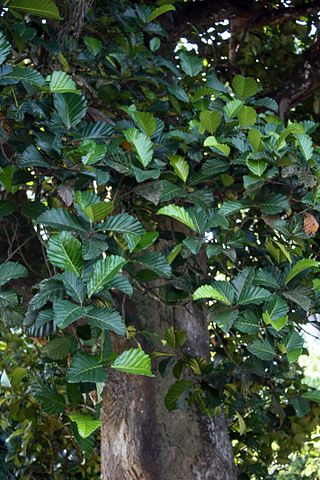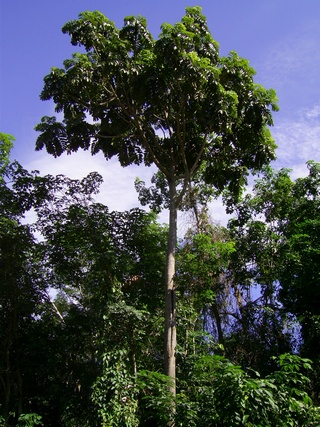
Breadfruit is a species of flowering tree in the mulberry and jackfruit family (Moraceae) believed to be a domesticated descendant of Artocarpus camansi originating in New Guinea, the Maluku Islands, and the Philippines. It was initially spread to Oceania via the Austronesian expansion. It was further spread to other tropical regions of the world during the Colonial Era. British and French navigators introduced a few Polynesian seedless varieties to Caribbean islands during the late 18th century. Today it is grown in some 90 countries throughout South and Southeast Asia, the Pacific Ocean, the Caribbean, Central America and Africa. Its name is derived from the texture of the moderately ripe fruit when cooked, similar to freshly baked bread and having a potato-like flavor.

The jackfruit is the fruit of jack treeArtocarpus heterophyllus, a species of tree in the fig, mulberry, and breadfruit family (Moraceae). The jackfruit is the largest tree fruit, reaching as much as 55 kg in weight, 90 cm in length, and 50 cm in diameter. A mature jackfruit tree produces some 200 fruits per year, with older trees bearing up to 500 fruits in a year. The jackfruit is a multiple fruit composed of hundreds to thousands of individual flowers, and the fleshy petals of the unripe fruit are eaten.

Antipolo, officially the City of Antipolo, is a 1st class component city and capital of the province of Rizal, Philippines. According to the 2020 census, it has a population of 887,399 people. It is the most populous city in the Calabarzon region, and the seventh most-populous city in the Philippines. And also, it is the most populated city under the component city status.

Artocarpus integer, commonly known as chempedak or cempedak, is a species of tree in the family Moraceae, in the same genus as breadfruit and jackfruit. It is native to Southeast Asia. Cempedak is an important crop in Malaysia and is also popularly cultivated in southern Thailand and parts of Indonesia, and has the potential to be utilized in other areas. It is currently limited in range to Southeast Asia, with some trees in Australia and Hawaii.

Artocarpus is a genus of approximately 60 trees and shrubs of Southeast Asian and Pacific origin, belonging to the mulberry family, Moraceae. Most species of Artocarpus are restricted to Southeast Asia; a few cultivated species are more widely distributed, especially A. altilis (breadfruit) and A. heterophyllus (jackfruit), which are cultivated throughout the tropics.

Artocarpus odoratissimus is a species of flowering plant in the Moraceae family. It is a commonly called marang, madang, timadang, terap, tarap, kiran, green pedalai, or johey oak. It is native to Borneo, Palawan, and Mindanao Island, and is closely related to the jackfruit, cempedak, and breadfruit trees which all belong to the same genus, Artocarpus.

Dipterocarpus caudiferus is a species of tree in the family Dipterocarpaceae, endemic to Borneo. It grows as a large tree, up to 65 metres (200 ft) in height. Its habitat is mixed dipterocarp forests up to 800 m (2,600 ft) elevation. Dipterocarpus caudiferus is threatened mainly by conversion of land for palm oil plantations.

Acacia confusa is a perennial tree native to South-East Asia. Some common names for it are acacia petit feuille, Ayangile, small Philippine acacia, Formosa acacia, Philippine Wattle, and Formosan koa. It grows to a height of 15 m. The tree has become very common in many tropical Pacific areas, including Hawaii, where the species is considered invasive.

Artocarpus nobilis, the Ceylon breadfruit, is a tree species in the family Moraceae. It is endemic to south western regions of Sri Lanka. It is known as "Wal dhel - වල් දෙල්", "Baedi dhel - බැදි දෙල්" or as "Hingala dhel - හිංගල දෙල්" by local people.

Toona calantas is a species of tree in the mahogany family. It is found in Indonesia, the Philippines, and Thailand. It is threatened by habitat loss. It is commonly known as kalantas, lanipga, ample, bantinan, danupra, Philippine cedar, or Philippine mahogany.

In Philippine mythology, the Tigmamanukan was believed by the Tagalog people to be an omen or augural bird. Although the behaviors of numerous birds and lizards were said to be omens, particular attention was paid to the tigmamanukan. Before Christianisation, the Tagalogs believed that the tigmamanukan was sent by Bathala to give hints to mankind whether they needed to proceed on a journey or not. In some Philippine creation myths, the tigmamanukan bird was sent by Bathala to crack open the primordial bamboo whence the first man and woman came out.

Gulaman, in Filipino cuisine, is a bar, or powdered form, of dried agar or carrageenan used to make jelly-like desserts. In common usage, it also usually refers to the refreshment sago't gulaman, sometimes referred to as samalamig, sold at roadside stalls and vendors.

Artocarpus anisophyllus, the entawak or mentawa, is a tropical tree in the Moraceae. It is native to the central parts of Southeast Asia, and is present in Peninsular Malaysia, Sumatra, Borneo and the intervening islands. It is called popwan in Palawan, Philippines.

Our Lady of Peace and Good Voyage, also known as Our Lady of Antipolo and the Virgin of Antipolo, is a seventeenth-century Roman Catholic wooden image of the Blessed Virgin Mary as venerated in the Philippines. This Black Madonna is enshrined in Antipolo Cathedral in the Sierra Madre mountains east of Metro Manila.

Artocarpus camansi, the breadnut, is a species of medium-sized tree in the family Moraceae. It is native to New Guinea, the Maluku Islands, and the Philippines. It is the wild ancestor of the breadfruit (Artocarpus altilis) and is also sometimes known as the seeded breadfruit, to distinguish it from its mostly seedless descendant. Breadnut fruits are edible when cooked. The large seeds can also be roasted and eaten.

The International Shrine of Our Lady of Peace and Good Voyage, popularly known as the Antipolo Cathedral and alternatively as the Immaculate Conception Parish, is a Roman Catholic cathedral in Antipolo, Philippines. It enshrines a venerated Black Madonna image of the Blessed Virgin Mary under the title of Our Lady of Peace and Good Voyage, and serves as the seat of the Bishop of Antipolo.

The baston is one of the primary weapons of Arnis and Filipino martial arts. It is also known as yantok, olisi, palo, pamalo, garrote, caña, cane, arnis stick, eskrima stick or simply, stick.

Artocarpus sericarpus, the peluntan, pedalai, gumihan or terap bulu, is a tropical evergreen tree species of the family Moraceae. It is the cousin of jackfruit and breadfruit.

The flora of the Philippines boasts a diverse array of plant species given its location in the great Malaysian flora. The Malaysian Phytogeographic zone is considered to be one of the most important centers for plant diversity because of the multitude and variance of species occupying that zone. The archipelago is isolated by a continental and deep ocean.


















